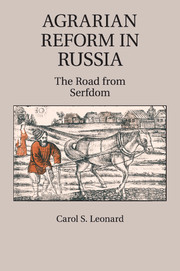Book contents
- Frontmatter
- Contents
- Tables and Figures
- Preface
- Agrarian Reform in Russia
- Introduction
- PART I DILEMMAS OF AGRARIAN REFORM IN RUSSIA
- 1 Imperial Reforms, 1861–1913
- 2 The NEP, Collectivization, and Post-Stalin Reforms, 1921–1989
- 3 The Transition Reforms, 1991–2010
- PART II RUSSIAN LAW AND RURAL ORGANIZATION, 1861–2010
- PART III RUSSIAN AGRICULTURAL PERFORMANCE, 1861–2010
- APPENDICES
- References
- Index
1 - Imperial Reforms, 1861–1913
Published online by Cambridge University Press: 01 June 2011
- Frontmatter
- Contents
- Tables and Figures
- Preface
- Agrarian Reform in Russia
- Introduction
- PART I DILEMMAS OF AGRARIAN REFORM IN RUSSIA
- 1 Imperial Reforms, 1861–1913
- 2 The NEP, Collectivization, and Post-Stalin Reforms, 1921–1989
- 3 The Transition Reforms, 1991–2010
- PART II RUSSIAN LAW AND RURAL ORGANIZATION, 1861–2010
- PART III RUSSIAN AGRICULTURAL PERFORMANCE, 1861–2010
- APPENDICES
- References
- Index
Summary
INTRODUCTION
There were two major property rights reforms in late imperial Russia, the emancipation of the serfs from personal bondage (1861–1863), and the Stolypin reforms, introduced by edict on November 9, 1906, and completed by legislative acts (1906–1910). Critically important for the evolution of secure property rights in Russia, the first reform replaced usufruct with peasant ownership of allotment land, thus severing landlords' sovereignty over the village and strengthening its governance unit, the Land Commune. Showing its conservative design, it made the nobles' implementation of land redemption voluntary. It also placed restrictions on peasant movement by empowering the Land Commune to approve resettlement, frustrating observers who had hoped for more rapid change. Forty-five years later, the Stolypin reforms finally allowed individual households to claim ownership and titles to allocated strips of land (nadel), to gather these strips into independent farms, and to dispense with the authority of the commune. These measures proved an effective model of land reform, taking agricultural development much further by the outbreak of World War I.
The social upheaval that resulted from Russia's entry into World War I increased social control over agricultural change. The spontaneous seizure of nobles' lands by the peasants in the summer of 1917 showed how fragile were the market institutions emerging from the grant of property rights in land. Agricultural development achieved before World War I, however, proved sustainable, giving both reforms profound economic significance.
- Type
- Chapter
- Information
- Agrarian Reform in RussiaThe Road from Serfdom, pp. 25 - 61Publisher: Cambridge University PressPrint publication year: 2010



